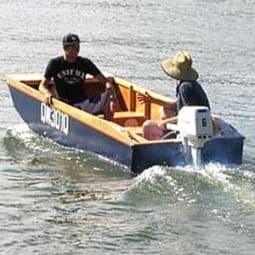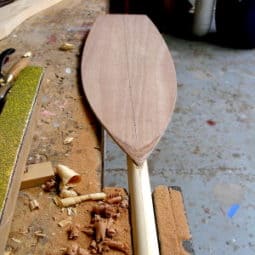An old boat has oil or diesel residue soaking the hull making painting or repairing difficult
A common problem with restoring or repairing an older boat is where an unpainted or poorly protected surface has been saturated with engine oil or similar – How to remove the oil or diesel from the timber

Nothing will stick very well. There may be repairs necessary in the area or you may want to epoxy seal the boat or section of the boat.
Of course this would not have happened in the first place had the timber been protected properly with epoxy (assuming the hull construction is compatible).
There is no foolproof method – but the method below has worked for Duck Flat Wooden Boats in a number of their restoration projects.
I asked them, because I didn’t know the answer when helping someone who wanted to use a high pressure hose and degreaser.
I think the Duck method works because they used time and the heat of the sun to do the work – it will always take TIME to get oil out of wood – it took years to get in there!
Trad Boats Repair and Modification Resource – USL Structural Code
Repair of Plywood Boats and Racing Dinghies Using Epoxy Methods
A Caution on using High Pressure Water Sprays with Timber
Be careful with the high pressure – they are but can do a lot of damage if not used carefully.
The most common types of damage are stripping surface veneers out of the ply and breaking glue joins between framing and ply.
If you keep it a good 200mls away from the surfaces it should be OK.
But maybe you don’t need a high pressure hose.
Removing Oil that has soaked into the boat’s timberwork the Natural (Wholistic) Way :)
Please don’t take the title above toooooo seriously! :-)
I spoke to David Wilson at Duck Flat about this – they had a restoration project that was saturated with engine oil.
Every time they put the hull out in the sun the timber would warm and more oil would seep to the surface.
They used a number of methods. Washing repeatedly with degreaser and solvent. But one thing they found useful was putting fine sawdust in the boat and leaving it in the sun – when the oil or diesel comes to the surface it was absorbed by the sawdust so then more oil would be able to come to the surface.
They basically kept going every few days for a few weeks until very little oil was coming out on the surface when the boat was left in the sun. They then gave it a degrease/solvent wash, let it dry properly in the shade over a few days – and kept it out of the sun until all the gluing work was complete.
It has lasted 10 years to date.
I think that’s a true record of what he told me.



















